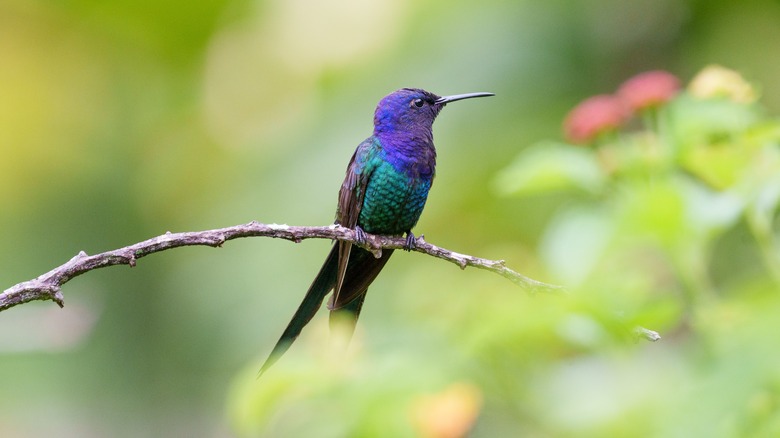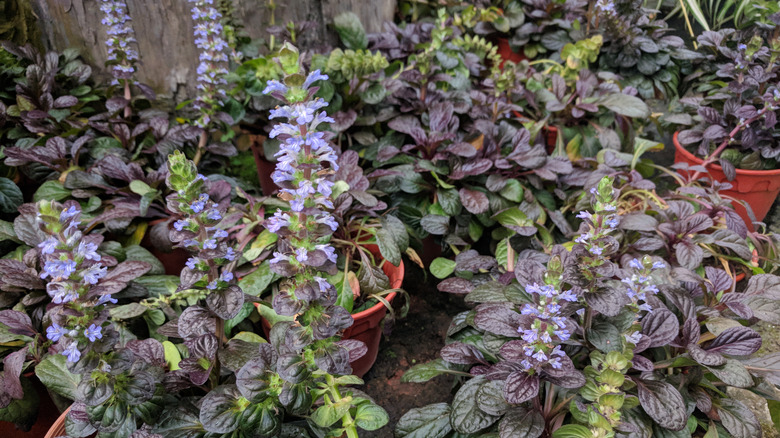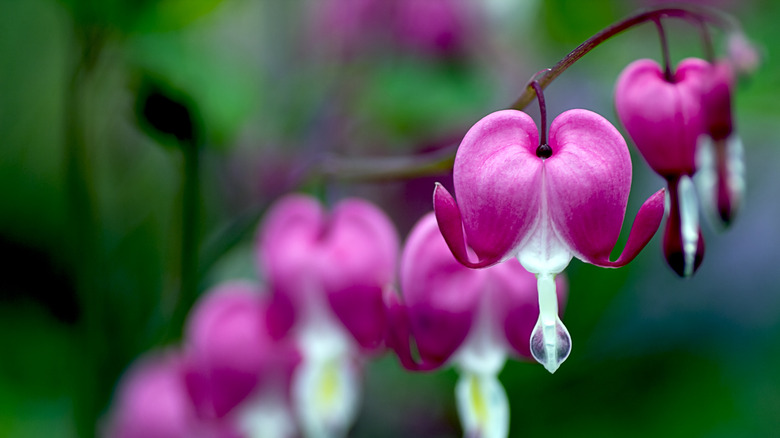Attract Hummingbirds With A Container Garden Combo That's Perfect For Shady Yards
Having hummingbirds flitting around your yard in the warmer months is a spectacular sight to see. They dart in and out of nectar-rich flowers at dazzling speeds, light glistening off their tiny bodies as they take advantage of what your plants have to offer them. These beautiful little creatures feed every 10 to 15 minutes and visit a whopping 1,000 to 2,000 flowers a day. So why not add a container garden to your yard to attract these hungry little birds and give them a nectar-rich buffet? Focusing on the shaded areas and adding a garden container combo of chocolate chip bugleweed (Ajuga reptans), cardinal flowers (Lobelia cardinalis), and bleeding hearts (Lamprocapnos spectabilis) will give these little guys the sustenance they need while filling your neglected shady spot with color.
Hummingbirds aren't just beautiful additions to your view, they're useful as well. They can help mitigate pests like small insects, beetles, ants, aphids, gnats, mosquitoes, and wasps, which are all part of their daily diet. Hummingbirds forage for nectar using sight, looking for tubular flowers that can accommodate their long bills. These birds love bright, colorful plants — particularly, add the color red to your garden to attract hummingbirds — which means your shaded yard will be a stunning dining room for them and an eye-catching floral display for you.
Add plants with colorful blooms
For ultimate success and beauty, follow the simple formula for designing your container garden of pairing thriller, filler, and spiller plants together. Chocolate chip bugleweed is a great filler plant since it's a ground cover. In the spring, you and your hummingbird regulars will notice bluish-purple tubular flowers pop up to feed your little friends. Include 4 to 5-foot-tall cardinal flowers as your thriller, which boast gorgeous white, pink, or blood-red tubular flowers in the late summer and fall – a real showstopper for an area with dappled sunlight. Too beautiful to resist as a spiller, bleeding hearts display pretty pink flowers in the shape of a heart that sit atop its stems. It grows to around 2 to 3 feet tall and wide, making its height a perfect complement to the others.
Plant the trio in a pot, raised planter box, or an aesthetically pleasing urn to give height and depth to a shady space. Hummingbirds won't be able to resist this staggered display with its array of eye-catching colorful flowers. Just be careful with the cardinal flowers and bleeding hearts since they're poisonous to humans and problematic for cats and dogs. You'll want to keep pets and children away from these plants.
The combo works because they have the same care needs
This combination works so well together, not just because of their colors and coordinating heights, but also their care requirements. The compatible light and soil needs make them a superb grouping. Chocolate chip bugleweed is a deep shade lover, as is the bleeding heart. Cardinal flowers can tolerate some dappled sun but will be perfectly content nestled with the other two in the shadowy part of your yard. All three of these beauties need moist soil, so tucking them into the same container is a no-brainer that makes your job of watering them quicker (so you can spend more time watching the hummingbirds feeding on them).
The USDA hardiness zones work in your favor here, too. Chocolate chip bugleweed is partial to zones 4 to 9, while cardinal flowers and bleeding hearts are both satisfied in zones 3 to 9. This triumphant trio will dazzle year after year because they're all perennials, so once you plant them the first time, you and your hummingbird besties sit back each spring and wait for them to come to life. Chocolate chip bugleweed is also an evergreen, which means you'll enjoy its burgundy-laced chocolate brown foliage all year round.
There are lots of benefits to growing a container garden in addition to attracting hummingbirds. You can enjoy the colorful plants and your flitting bird buddies for years to come with these flowers in your container garden. There's no doubt you'll have them darting about your shady yard to enjoy all the nectar their little bodies can handle.


